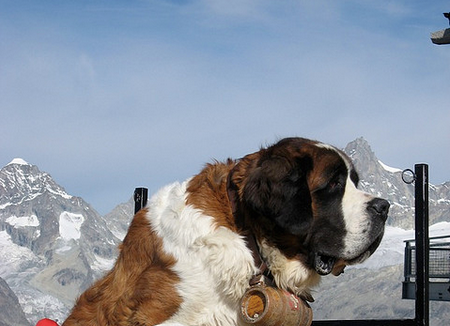Profiling Four of the Largest Dog Breeds in the World

Dogs come in all shapes and sizes, but some grow to be especially large. Breeds like the Great Dane and the Newfoundland are unique not only for their matchless girth, but also for their origins and other exceptional characteristics and traits.
Great Dane
Iconic physical specimens, Great Danes are renowned for their substantial size and amiable demeanors. Standing at an imposing average height of 28-34 inches, they’re widely regarded as one of the largest dog breeds in the world. One of the main breeds of choice for European nobility since the 16th century, Great Danes were coveted for their ability to participate in both recreational outdoor activities and more subdued indoor environments. Males can weigh up to a staggering 200 pounds, while females tip the scales at a slightly more slender 130 pounds. Their coats come in a wide variety of colors and patterns.
Dogs bearing a strong resemblance to the Great Dane breed occupy space on ancient Egyptian monuments in the forms of drawings and sculptures, evidence to the breed’s rich pedigree. The modern-day Great Dane is the direct descendant of a crossbreeding experiment between an Irish Wolfhound and an English Mastiff, and was originally developed as a hunting accomplice. Over time, its duties and responsibilities became more docile in nature, focusing more on companionship and estate protection. This combination of reverent history, aristocratic tradition, massive size and steadfast pop culture relevancy–thanks to cartoon legend Scooby-Doo–has established the Great Dane as one of the premier large dog breeds in the world.
Saint Bernard
Throughout history, the expansive European mountain range known as the Alps has presented a treacherous challenge to hikers. Freezing temperatures, uncompromising storms and hidden obstacles posed constant dangers to explorers. Tasked with their rescue were locals who relied on the tracking abilities of the celebrated Saint Bernard, a large dog with a thick coat that is perfectly suited for cold-weather survival and navigation. The breed was originally named after the Great Saint Bernard Hospice, a local haven for travelers that used dogs to assist with rescue efforts.
Nowadays, Saint Bernards are valued as loyal, lovable household companions. Their average height generally falls between 25-27 inches, and their weight typically fluctuates between 100-200 pounds. The breed comes in long- and short-haired varieties that both require extensive grooming. Owners should prepare themselves for a lot of drooling, which is a well-known breed trait. Large and undeniably cute, Saint Bernards occupy a special place in the canine landscape, thanks to both their remarkable history and sweet nature.
Note: If you’re looking to protect your canine, consider looking into a Pet Insurance plan like ASPCA Pet Insurance. As a safe option for pet care, ASPCA Pet Insurance can help you afford the care your pet needs.
Newfoundland
A regular in the Newfoundland fishing scene, the eponymous Newfoundland dog originally was tasked with assisting fisherman by dragging nets. They’re the prime example of a breed developed to fulfill a specific purpose. They boast unparalleled swimming abilities thanks to both innate instinct and webbed feet ideal for water propulsion. Their thick, oily and waterproof double coats protect them from the frigid outdoor temperatures. As with Saint Bernards, though, Newfoundlands will treat their owners to a perpetual stream of drool.
Newfoundlands are adored for their calm disposition and unshakable loyalty. These traits were described perfectly by Lord Byron in his poem Epitaph to a Dog (1808), which was inscribed on a monument to his own beloved Newfoundland.
“Near this spot are deposited the remains of one who
possessed Beauty without Vanity,
Strength without Insolence,
Courage without Ferocity,
and all the Virtues of Man,
without his Vices.
This Praise, which would be unmeaning
Flattery if inscribed over human
ashes is but a just tribute to the Memory
of Boatswain, a Dog…”
Great Pyrenees
Like many large dogs, the Great Pyrenees possesses a history of accomplishing essential outdoor duties while enjoying the favor of the region’s aristocracy. In this case, the service was helping shepherds guard livestock, protecting the herd from predators and thieves. When confronted, the Great Pyrenees is stoic in the face of danger and won’t back down from a fight. This resulted in the breed being revered by members of the French nobility, such as The Grand Dauphin, the eldest son of Louis XIV, who loved the dog for its territorial/defensive qualities and affectionate demeanor.
A Great Pyrenees weighs roughly 120 pounds. and can stand as high as 39 inches. While their primary color is white, they can also feature shades of red and gray. They’re infamous for displaying stubbornness, a direct result of their territorial mindset and origins. The breed can still be found in farms across the world guarding livestock.
Note: Breed information gathered from various online sources.
